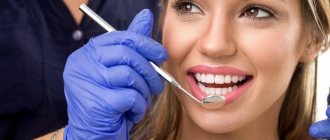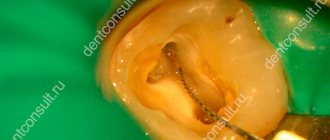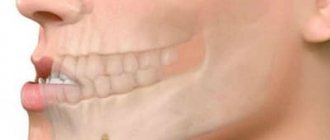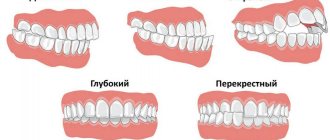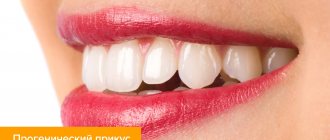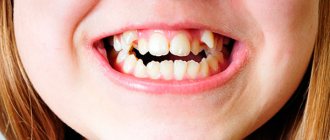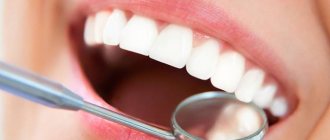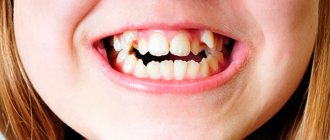Having managed to grow up, many never met an orthodontist, although they visit other specialists in dental clinics.
It may surprise you, but of all the dental specialties, orthodontics is primarily responsible for the condition of teeth and gums, a harmonious face and a beautiful smile, as well as for the general health and psychological comfort of a person.
What’s even more interesting is that very often, orthodontic treatment allows you to achieve all of the above without pain and surgical intervention, only through the use of “small forces” , which we will talk about in this article.
The term ORTHODONTICS comes from the Greek words orthos - straight , correct and odus, odontos - tooth and was first used in 1840, but the treatment of defects in the dental system began much earlier.
Initially, the task of ORTHODONTICS was to correct the incorrect position of individual teeth. As a rule, the anterior teeth of the upper jaw were treated solely for aesthetic reasons. Treatment could be reduced to pressing with a finger on a crooked growing tooth, removing or rotating the teeth with forceps.
As it develops, orthodontics has become a medical discipline that studies the causes of dental anomalies, their impact on the human body and the creation of effective methods of prevention and treatment.
The demand for orthodontic treatment is constantly growing and today braces are a sign of wealth, a demonstration of concern for one’s health and beauty.
Let's figure out why it is necessary to correct defects in the dental system and get acquainted with the methods of orthodontic treatment.
Installation of braces in adulthood
Orthodontic treatment with braces in Russia goes back about thirty years. And in the USA, for example, bite correction with braces has been practiced for more than a hundred years. Russian orthodontists today often work with adults who simply did not have the opportunity to undergo this level of treatment in childhood. As a rule, such patients themselves turn to the dentist, less often - through the referral of related specialists. As a rule, people come to orthodontists for a beautiful smile, and not because of any pain. Most of those applying are women. Men are more relaxed about imperfect smiles, although doctors have recently noted an increase in the number of male patients.
What can be the consequences of an incorrect bite?
Lifespan
Scientists have now proven that people with correct bites live 20% longer.
One example is that with an incorrect bite, the lower jaw very often takes a posterior position, which reduces the lumen of the respiratory tract, in turn this leads to oxygen starvation of the heart and brain, and if this continues throughout life, you understand what changes can occur. And this is just one example. That is, this is not just aesthetics, as many people think - this is a real problem that can affect everyone, both children and adults.
Missing sixth teeth
Another example is the absence of sixth teeth, what could be the problem here? Our sixth teeth are the keys of occlusion, that is, they support the height of the lower jaw and the position of the lower jaw. When we lose or remove these teeth, some time passes and we do not make up for this loss, the position of the jaw changes, the height of the lower third of the face changes to a lesser extent - this is how an incorrect lower bite begins to form. Accordingly, the front teeth begin to wear out, because the load is redistributed from the back to the front.
What happens with this? Patients come to the dentist, ask for crowns, make some restorations, but do not take into account the position and malocclusion of the lower jaw, which has already changed pathologically.
Absolutely the same clinical picture is observed in the upper jaw; the absence of six teeth forms an abnormal bite.
Impaired diction and more
Along with dental disorders and defects that are associated with malocclusion, there is also a violation of diction. At the same time, the psychological state of the patients is not balanced: people cannot speak in public, they cannot smile brightly, well, beautifully. All these are the consequences of malocclusion, which, unfortunately, not everyone is ready to treat on time or even on time.
TMJ, bite and posture
Moreover, there are very serious consequences with the musculoskeletal system, because the temporomandibular joints (TMJ) suffer greatly from bite asymmetry. And then the disease may develop uncontrollably; changes may occur in the cervical vertebrae, then in the thoracic and lumbar spine, and this is the basis of our skeleton.
When a person begins, for example, to innervate a muscle, say, the arms or calves, he will pay 100% attention (!) not to the bite, which is incorrect. And it will be difficult to determine this at an older age, but you can and should start correcting malocclusion at any age.
Does it make sense to get braces as an adult?
Correcting a pathological bite or incorrect position of teeth is, of course, not a matter of life and death. Rather, it is a matter of regaining self-confidence. The “curvature” of teeth has little effect on communication; after all, we perceive a person holistically, and not solely the state of his bite. But, you see, an open wide smile of any person will make him more attractive in our eyes. And only people who are not embarrassed to show off their teeth smile like that. Plus, when we talk about bite, it's not just about beauty, it's also about functionality. Nature intended that when chewing, the load on the teeth should be distributed evenly - this is only possible with straight teeth and a healthy bite. If this is not the case, then over time a person develops problems with the dental system: pain appears, clicks when opening and closing the mouth, etc. Therefore, orthodontic treatment for adult patients is not only possible, but also necessary.
Why, when and how to correct malocclusion
What is orthodontics?
This is a section of dentistry that studies the causes, diagnostic methods, clinical picture and methods of treatment of persistent anomalies and deformations of the dentofacial system and teeth in adults and children. The main task of orthodontics is to achieve a harmonious smile through the study and implementation of new techniques. Since all orthodontics is largely tied to bite correction, let's take a closer look at what a bite is. The bite is the relationship between the upper and lower jaws when the maximum number of teeth are fully closed. The “key of occlusion” is the relationship of the “sixth” teeth of the upper jaw with the “sixth” teeth of the lower jaw.
What malocclusions occur?
There are three types of occlusion that occur most often: orthognathic (normal), mesial and distal. In addition to them, there are open, cross, deep and various combinations of all of the above; we will analyze each of them. 1. Orthognathic - each tooth has contact with 2 antagonists, each upper one has the same lower and one behind it, each lower one with the upper one and the one in front, with the exception of wisdom teeth. When closing, the teeth are in a position of central occlusion - maximum fissure-tubercle contact of the chewing teeth, the upper incisors overlap the lower ones by 1/3 of the height of the crown. The central lines between the incisors coincide, the lower cusps are in contact with the dental cusps of the upper incisors. We see harmonious facial features. 2. Mesial (progeny) - displacement of the lower jaw forward relative to the upper, we have a “concave” facial profile, in the mouth the buccal tubercle of the sixth tooth of the upper jaw is located behind the longitudinal groove of the sixth tooth of the lower jaw. Progenic occlusion can be physiological, when no persistent morphological changes and disturbances are observed, or pathological. 3. Distal (prognathia) - the upper jaw is strongly developed, overlaps the lower one, we have a “convex” bird’s profile of the face, the incisors do not close, as the anterior section is lengthened or shortened, and the chewing teeth close incorrectly due to the narrowing of the corresponding section, which contributes to formation of a block for the growth of the lower jaw. It can also be physiological, when there are no persistent morphological changes and disorders, and pathological. 4. Open - a gap between the front teeth in the vertical plane, less often in the lateral section. The facial profile is elongated, the mouth is slightly open, the nasolabial folds are smoothed. The chewing teeth often become elongated, and the tongue becomes compensatory in size. 5. Deep - the incisors of the upper jaw excessively overlap the lower ones in the vertical plane, there is often increased abrasion and chipping of tooth enamel, a decrease in the lower third of the face, a “bird-like” profile, as with prognathism, the upper and lower lips protrude strongly forward. 6. Crossed - a violation of the overlap of the chewing teeth, characterized by a displacement of the midline of the incisors, asymmetry of the corners of the mouth, and there may be a displacement of the chin to one side. Before we look at why it is necessary to correct malocclusion, we will consider the main causes of malocclusion: they are divided into two large groups - congenital and acquired.
1. Congenital:
- Genetic predisposition
- Intrauterine disorders of jaw development. The formation of teeth occurs at 6-7 weeks of intrauterine life, at which time a woman is often unaware of her interesting situation and can easily expose herself to the negative influence of external factors.
- Injuries to a child during childbirth.
2. Purchased
- Improper organization of breastfeeding and artificial feeding, use of inappropriate pacifiers and bottles.
- Bad habits: sucking objects, incorrect body position when sleeping and waking, mouth breathing.
- Diseases in childhood: rickets, endocrine disorders (diabetes mellitus, hypo and hyperfunction of the thyroid gland, ENT pathology (adenoids, sinusitis).
- Early loss of baby teeth due to caries and its complications and injuries, without timely orthodontic treatment.
Problems that can result from an incorrect bite.
First of all, when occlusion is violated, excessive load falls on the teeth, they are abraded, enamel cracks appear, wedge-shaped defects in the cervical areas, bone loss and, as a result, gum recession due to tooth displacement, and oral hygiene is disrupted.
All this can lead to early tooth loss. In addition, malocclusion affects the shape of the face, profile, appearance and a person’s self-acceptance. When and how should a malocclusion be corrected?
If you notice any of the following symptoms in yourself or your child, you should contact an orthodontist for a consultation, and in the case of a child, there is no need to wait until adolescence.
1. Impaired closure of the anterior or chewing teeth. 2. If there are gaps between the teeth, but it is important to remember that in the period from 6 to 12 years there is a physiological change of milk teeth to larger permanent ones, the child experiences active jaw growth, milk teeth seem very small and this is a very good sign. This means that, with a high degree of probability, all permanent teeth will fall into place, and bite problems will be avoided. 3. If there is a violation of the position of the teeth, they stand “crooked”. 4. Impaired lip closure, facial asymmetry, unharmonious profile. 5. Bleeding gums, pain in them, rapid formation of hard dental deposits, taking into account frequent professional hygiene. 6. Poor posture, stoop. Very often, malocclusion is accompanied by these symptoms. Problems with bite should be brought to the attention of a pediatrician during annual preventive examinations. If you, as a parent, have any doubts, do not hesitate to ask your doctor. It is important that early treatment is started as soon as possible. The final diagnosis of a particular malocclusion pathology is made individually based on a clinical examination, various functional tests, and x-ray diagnostics. After this, the doctor begins treatment planning. At a younger age, they begin with conservative techniques - myogymnastics, posture correction, and the elimination of bad habits. Subsequently, various devices are manufactured, often non-removable for constant wear. I would like to note that even with a relatively short period of wearing them (several months), you can achieve very good stabilization and, with a responsible approach with a competent orthodontist, solve the problem of malocclusion in childhood. I would also like to dwell on one of the treatment methods - installing a brace system. The possibilities of modern braces systems are very wide. This is a non-removable long-term device that is installed on the vestibular or lingual surface of the teeth. Consists of: grooves that are fixed to the teeth in certain places of the crown using special adhesive systems and ligature wire, which is fixed in these grooves. Also, if necessary, use special elastic bands and metal rings. Everything is simple at first glance. The theory of treating malocclusion with braces is based on two important discoveries: material with a “shape memory” effect and the principle of “low forces”. What does it mean? At the turn of the 21st century, the National Space Agency developed an alloy of nickel and titanium that can "remember shape" and return to it when special temperature conditions are created. When planning treatment, the doctor determines the position that the teeth should ultimately occupy and “programs” this movement by giving the metal arch the desired shape. When the archwire is attached to the teeth and heated in the mouth, it tends to the “programmed” shape and moves the teeth into the desired position. The second important discovery that formed the basis of treatment with braces is the principle of “low forces”. Over time, it has been found that the "slow" movement principle is most effective for moving teeth. Tooth movement occurs due to the resorption of bone tissue on one side of the tooth being moved and the formation of bone on the other side to fill the resulting space. It is recommended to correct the bite with a brace system from adolescence from the age of 13, but it is possible earlier if the benefits outweigh the possible risks for the still unformed roots of the teeth. Advantages and features of various bracket systems.
Based on the material used, braces are divided into: 1. braces with metal locks - the most effective, take up less space on the tooth, but are especially noticeable to others 2. plastic, ceramic or sapphire braces - the material from which they are made speaks for itself .
Plastic ones are more affordable, but can change color from food coloring and are fragile. Ceramic and sapphire are reliable, less durable than metal, and sapphire is also transparent, which makes them almost invisible. According to the method of fixation:
1. Ligature - the arch is fastened in the bracket using special rubber ligatures of various colors. 2.Self-ligating (self-closing) braces, the wire is fixed directly to the bracket lock. These structures can distribute pressure force independently. Compared to ligature braces, self-adjusting braces are more expensive, but they are used more and more often, since they are more convenient for patients, with them treatment is faster and more comfortable for both the doctor and the patient. After installing braces, you need to give yourself time to get used to them. In the first few days, foreign objects in the mouth cause physical and psychological discomfort. Pain syndrome may occur, because the arc affects the teeth, forcing them to take a normal position that is unusual for them. You may have difficulty eating and caring for your mouth, but your doctor will teach you all of this. The thought that your teeth will be straight after braces should give you some comfort. But it is important to understand that after removing the braces, the treatment does not end; you will have to wear a miniature retention arch, which will be unnoticed, but will be fixed to the teeth to secure the result of the treatment. I would like to say a few words about another method of treating malocclusion - the use of aligners. Aligners are removable transparent individual aligners for the upper and lower jaws, made of biosilicone or bioplastic. Just like braces, they are permanently fixed on the teeth, except during hygiene periods. Unlike braces, they are more aesthetically pleasing and to some extent easier to care for, but the range of cases of their use is limited to simple disorders. The most optimal treatment option for malocclusion will be offered to you by an orthodontist during a face-to-face consultation and will tell you all the pros and cons of each system. The choice is yours. We look forward to seeing you at our Family Stom dental clinic in the center of Arkhangelsk - to restore the health and beauty of your smile as soon as possible!
At what age does it make sense for adults to get braces?
In any case, there are no age restrictions. There are surmountable obstacles: the general condition of the teeth, periodontal and gum diseases, and possible common concomitant diseases. Absolute contraindications for installing braces for adults coincide with many other types of treatment: lack of teeth, tuberculosis, diabetes, a number of immune diseases, epilepsy, bone pathologies, blood diseases. If a person gets braces when he is over thirty, the treatment will be quite long, since tissue regeneration occurs more slowly due to age. Plus, skeletal growth has already been completed, and the position of the bones can be “corrected” only when they are still growing - in childhood and adolescence. However, dentists achieve excellent results with mature patients.
Contraindications for installing braces
Even if there are indications for orthodontic correction using a brace system, it happens that such therapy may be contraindicated for a particular patient. Prohibitions are divided into relative and absolute. Relative restrictions include those that are temporary, for example, the acute course of a disease.
Relative contraindications:
- periodontal diseases;
- dental diseases (caries, pulpitis, etc.);
- pregnancy;
- bruxism.
Absolute contraindications:
- partial edentia (absence of a large number of teeth);
- oncology;
- osteoporosis and other bone diseases;
- mental illness;
- endocrine diseases;
- HIV AIDS;
- tuberculosis.
Specifics of treatment with braces in adults
Adult patients should keep in mind that it is often necessary to remove teeth to achieve a high-quality result of orthodontic treatment. This does not mean that every patient needs it; removal is carried out only in cases where there is not enough space to restore the normal position of the teeth. Foreign orthodontists change the jaw size of adults using surgery. In Russia, orthognathic surgery is not yet particularly widespread due to the fact that our patients are extremely reluctant to agree to undergo operations. Let us repeat that this is just information about how it might be. In most cases, orthodontic treatment for adults is limited to simply installing braces.
Which braces are most often installed in adults?
It is most rational to choose metal braces: they are the most durable, and since the treatment will be long, this is one of the most important indicators. When it comes to minor corrections, aesthetic systems made of ceramics or artificial sapphires can be installed. But, let’s say, ceramic braces are quite fragile compared to metal ones. If the ceramic lock is chipped, you will need to remove it and install a new one. And this is a waste of time: when the lock is re-glued, the treatment can be considered to begin anew. When choosing a brace system, it is best to listen to the orthodontist’s recommendations - the doctor selects or combines types of structures so that the treatment is as comfortable as possible.
Is it possible to correct an adult's bite without braces?
You can - with the help of aligners. These are orthodontic transparent aligners made of solid polymer. Despite their rather simple appearance, aligners cope well with both minor changes in the position of the teeth and quite serious pathologies of the dentofacial apparatus. When treating with orthodontic aligners, patient motivation is extremely important. Aligners are more often chosen by men - they think that this type of treatment is less problematic. But they often lack patience and remove the aligners as soon as they feel discomfort. And this is unacceptable if the patient expects a positive effect of treatment. Aligners need to be worn 22 hours a day - keep this in mind before choosing this treatment option. If you comply with this requirement, then treatment with braces will not be necessary - mouthguards are no less effective at restoring the anatomically correct position of the teeth and correcting the bite.
Bite and body position in space
There is a connection between the condition of the dentition and a person’s ability to control his body. In 2016, a team of authors from Spain published a paper suggesting that occlusal abnormalities negatively affect postural control.
Postural control is a person’s ability to control the position of his body in space. It includes concepts such as postural stability and postural orientation. The first is associated with the ability to maintain a vertical position in any situation, the second – with the ability to interact with individual parts of the body in space.
Stability and orientation are determined by the work of the vestibular nuclei of the brain. The functioning of these nuclei is influenced by a large number of factors, including impulses from the trigeminal nerve, of which sensory and motor fibers are part. The branches of the trigeminal nerve go to many anatomical structures on the face, including the masticatory muscles, the rhythmic contractions of which ensure the grinding of food with the teeth.
Improper closure of the dentition, changes in the load during chewing through a feedback mechanism changes the tone of the muscles of the neck and upper back. This, in turn, affects posture, gait, and coordination of movements. Different parts of the musculoskeletal system are connected to each other, so changes that begin in the neck can lead to the development of flat feet and other “remote” disorders.
In everyday life, ordinary people may not notice the existing problem with coordination of movements and movement of the body in space. But in professional sports, all this can have adverse consequences: affect training results and increase the likelihood of injury.
The good news is that the musculoskeletal system is a dynamic system in which individual parts are constantly “adjusting” to changing conditions. This means that correcting the bite improves the ability to have postural control.
What are the best “adult” braces according to reviews?
Most adult patients respond positively to lingual braces. They are fixed on the back surface of the teeth and are absolutely invisible to others. This type of braces has the lowest profile: the clasps of the systems are lower than all others, and therefore do not interfere with diction, do not irritate the mucous membranes, and do not scratch the tongue. Adults also often choose non-ligature ceramic braces - they are practically invisible, quite durable and cheaper than sapphire structures. When choosing a vestibular system that is fixed on the front surface of the teeth, it is worth considering that no matter what invisible material its clasps are made of, the orthodontic arch will always be noticeable. Therefore, you can safely choose classic metal braces. Ultimately, preference for a particular design comes down to its price.
Retainers: why are they worn after braces are removed?
A retainer is a device that looks like an arch. It is placed on the back surface of the teeth when braces are removed. This way the new position of the teeth is secured. The ligamentous apparatus of the teeth has muscle memory, so no matter how we move the teeth, they will tend to return to their “original” position. Wearing a retainer is an essential part of orthodontic treatment. This is especially true for people over twenty-five years of age. A retainer is installed for at least two periods of wearing braces: for example, the patient wore them for one year, then the retainer will need to be worn for two years. Foreign orthodontists generally argue that you need to wear retainers constantly - this is the only way to guarantee that your teeth will remain straight. In general, after some time the retainer can be replaced with a night guard or plate. But some kind of structure supporting the new position of the teeth will definitely be needed - this is a classic. Unfortunately, patients often neglect this stage of treatment, experience relapses and begin to talk about the ineffectiveness and uselessness of orthodontic treatment in adulthood.
Types of bite
With a correct or physiological occlusion, the teeth in a row have tight contacts, the chewing surfaces of the antagonist teeth evenly close, and the upper incisors overlap the lower ones by a third.
Types of malocclusion:
- Distal - the upper jaw protrudes significantly forward relative to the lower jaw, there may be a sagittal fissure - the gap between the upper and lower incisors,
- Mesial - the lower jaw protrudes forward relative to the upper jaw. There may be overlap of the upper incisors with the lower ones, although not always,
- Open - closure in the vertical plane is disrupted, when individual teeth or sections do not close with each other on the lower and upper jaws,
- Deep - vertical violation of closure: the position of the upper front teeth is too low - they can cover the lower ones half or entirely,
- Cross – teeth overlap each other in different sections: the upper teeth are hidden behind the lower ones or, conversely, completely overlap the lower ones in the chewing sections.
How long should adults wear braces?
It is impossible to answer this question unambiguously: maybe one year, or maybe several years. Bite correction in adult patients is a long, labor-intensive process that requires patience and discipline. Therefore, orthodontists rarely persuade adults to straighten their teeth. If a person himself does not want this, then nothing will force him to conscientiously fulfill all the doctor’s demands. When treating adults with orthodontics, it is important that the dentist find a compromise between what he wants to achieve and what the patient wants to achieve. Orthodontists, of course, always strive to restore the perfectly aligned position of teeth, no matter how long it takes - at least three years, at least five years. The patient may get tired of the treatment and abandon it. The dentist’s main task is to honestly tell you how long the treatment will take and how it will proceed. And then hear whether the patient is ready to go this route.
Occlusion and dental health
The most common problem that owners of malocclusion face is the difficulty in carrying out daily hygienic cleaning. Teeth that are close to each other are poorly cleaned of plaque and tartar, which increases the likelihood of developing caries and inflammatory gum diseases.
Uneven distribution of the load on the dentition during chewing causes rapid abrasion of tooth enamel. Increased stress on periodontal tissue, which holds the roots of the teeth in the jaw bone, can lead to gum recession, subsidence of the bone plate and soft gum tissue, exposing the roots of the teeth. Chronic periodontitis is difficult to treat and significantly worsens a person’s quality of life.
The pathology of the closure of the dentition has an adverse effect on the condition of the temporomandibular joints. Degenerative-dystrophic phenomena in the joints are manifested by pain, crunching and clicking when chewing.
Price of braces for adults in Moscow
To avoid misleading you, we will not indicate specific amounts. Because orthodontic treatment for adults is time-consuming and often requires additional or preparatory procedures, its overall cost cannot be low. But the opportunity to smile broadly without embarrassment is priceless at any age! Therefore, it makes sense to schedule a consultation with an orthodontist, no matter how old you are. After examination and research, the doctor will tell you the exact cost of treatment in your case.
